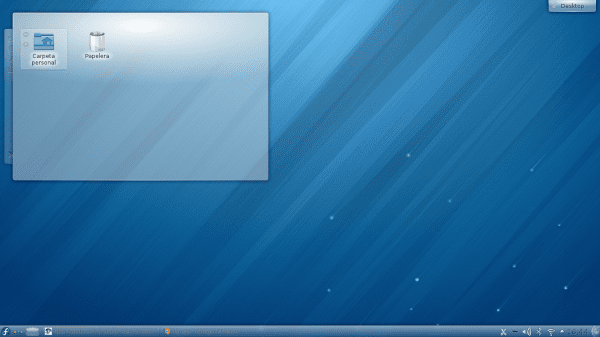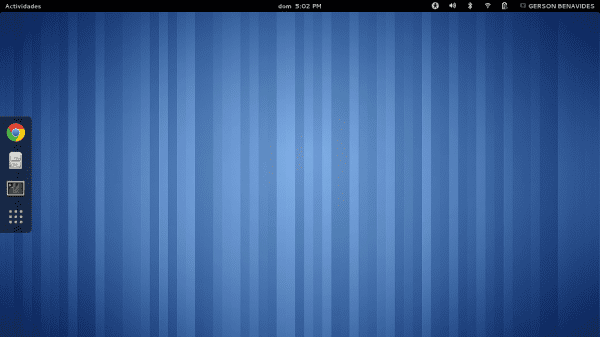I do not know if it has happened to many that they have X or Y system with a certain desktop environment (in my case Gnome) and they want to try another but they don't want to format the whole system.
Well, in this post I would like to show you how to test KDE in a system with Fedora / Gnome. In summary when you go to start section you can select with which environment to start. OK we start.
The first thing to do is add the kde-red repositories that we will do this way
yum -y install wget && wget http://apt.kde-redhat.org/apt/kde-redhat/fedora/kde.repo -O /etc/yum.repos.d/kde.repo
Then you have to activate them (Personally I have been activated but verify that they have been activated)
sudo nano /etc/yum.repos.d/kde.repo
Search the word Enable and change its value to 1 (Enable = 1).
Guarda
yum update
Now you just need to install KDE
yum install @kde-desktop
Image taken from http://www.clopezsandez.com/2012/06/instalando-kde-sobre-gnome.html
Well that would be all I hope it has served you 😀 Some screenshots
KDE
GNOME
SOURCE: http://deknileech.info/como-instalar-kde-sc-4-8-en-fedora/




Does it work the same for FUDUNTU 2013.1?
I'm going to try it.
EDIT: It can't be done in FUDUNTU; this pops up:
http://mirror.unl.edu/kde-redhat/fedora/2013/i386/testing/repodata/repomd.xml: [Errno 14] HTTP Error 404: http://mirror.unl.edu/kde-redhat/fedora/2013/i386/testing/repodata/repomd.xml
Trying another mirror.
Nothing to do
Fuduntu is no longer compatible with Fedora, it was forked long ago.
WTF? And now what is it based on?
@elav, it is now an independent distribution.
And all to keep gnome 2
WTF?
que? Using the redhat-kde repo I don't use it and I wouldn't recommend it, if kde already comes in fedora's own, just doing a kde-desktop groupinstall more than enough.
Well, the method is fine if it is to test KDE and continue working with Gnome or Gnome applications. But if you want to use KDE, that is, Fedora with KDE or any other distribution with KDE that has Gnome by default, it is not the best option. In my case I have used KDE for many years in Fedora and the best option, clean and without errors has been to use the Fedora KDE Spin, you will have a total kde experience. If you use the DVD with gnome by default and install KDE later, you won't get the same, I tell you from years of experience.
I only recommend using the DVD with gnome by default in Centos and Scientific Linux, but beware !!! don't install gnome. During the software package installation process, it is necessary to deactivate all the Desktop options that are activated by default (of course they are from gnome) and choose KDE Desktop. Personally I also go into some package groups and disable 3 or 4 gnome programs (evolution, packagekit, some totem plugin, etc.) to have everything absolutely KDE at the end. And it works like a charm. I even get bored of not having problems.
Conclusion: if you like KDE, don't install Gnome and then KDE, if the distribution allows it.
That's true, although I understand that on the Fedora 18 DVD, choosing KDE automatically installs that environment without having to select and deselect applications. I didn't test it so if someone did it would be nice to know.
Exactly, from the DVD you can choose KDE without having to install it after having originally installed with Gnome. But the KDE that you will get will be different than the one obtained with the Spin, which I recommend. I haven't tried version 18, I can't tell you how it is but I bet it's still the same. For example, I think I remember that the office package is more complete with the dvd than with the spin that koffice brought, as well as some exclusive KDE programs that are not installed by default with the dvd. That is why I said that if you are looking for a more complete environment, KDE should do it from the spin, and then install the program you need, since the spin is smaller in software.
The select and deselect thing is because in Scientific Linux, for example, there is no separate KDE option, all software is chosen during installation. As it is oriented to Gnome by default, even if you choose KDE Desktop it will install you many essential applications of the gnome system. What I do is check them and deactivate them. I have done it many times and in seconds it is solved, but anyone who does not know will be reviewing them for a while but it is not very annoying to say. The only gnome application that you have to leave, because otherwise you won't have internet, is NetworkManager, there is no equivalent in KDE and if you don't install it, it's over. For the rest, I deactivate in the Desktop section, everything that belongs to gnome, and I also activate IceWM, which I need for another old computer. I have to say that I also leave Grsync, firefox and thunderbird because it does not have exaggerated dependencies. On the other hand, a program that I like a lot is Disk Utility but I don't install it because it requires nautilus and if I have dolphin, I will also install it.
Likewise, as you say, especially with Fedora, I always advised to install Spin, where KDE is very well integrated into Fedora.
regards
Installing the two environments is counterproductive, you will cause an impressive package crap xd
And most uncomfortable, in both environments all the applications appear, an unpalatable salad….
And isn't it easier to install KDE directly from the DVD?
Of course, but one always wants to try, also there are no duplicate programs such as terminals, that you will have the gnome terminal, the xfce terminal (?) and kde konsole, or nautilus, dolphin and konkeror to see files ... in fact of likes, no dislikes
I tried the KDE, what a horrible thing. It takes a long time to load even though I have 4 gigabyte memory. But thanks. So I know that KDE is not for me. I stay with Gnome 😀
Hi, I have installed KDE from grouplist, but I can't start it. I have the application packages installed, but I still need to start and I tried to log out but that option to select desktop environment does not appear ... Can someone help me? Thanks a lot!
the step «» »» sudo nano /etc/yum.repos.d/kde.repo »» »»
I can't do it because the kde.repo file doesn't show me anything, the file is empty.